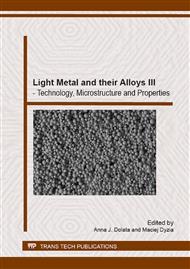p.57
p.65
p.71
p.77
p.83
p.89
p.93
p.101
p.109
High-Cycle Fatigue Life of AZ31 and AZ61 Magnesium Alloys
Abstract:
Usefulness of the magnesium alloys for construction of structural components is determined, apart from their low density, by a number of favourable mechanical properties and in the case of their use for components of transport means additionally by good fatigue strength. In this study, 12 mm diameter extruded rods of AZ31 and AZ61 magnesium alloys were used as test material. After extrusion the rods were annealed at a temperature of 400°C, with a 60 min soaking period and subsequent cooling in air. Cylindrical specimens with a diameter of d0 = 8 mm were made for the fatigue test under high-cycle rotary bending conditions with the cycle asymmetry coefficient R = -1. The tests were carried out for a limited fatigue strength range. Examination of microstructure of tested alloys and fatigue fractography were also performed. During the high-cycle fatigue tests it was found that the AZ61 alloy has a longer fatigue life. Based on the obtained results, fatigue life characteristics of the tested materials were drawn up.
Info:
Periodical:
Pages:
83-88
Citation:
Online since:
November 2013
Authors:
Price:
Сopyright:
© 2014 Trans Tech Publications Ltd. All Rights Reserved
Share:
Citation:


